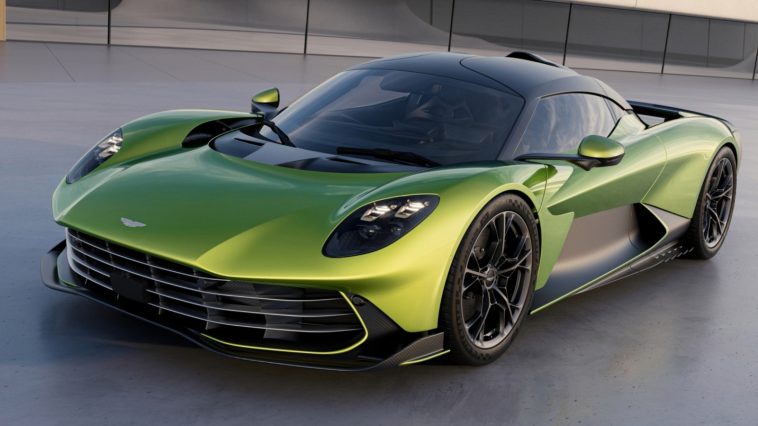Aston Martin
Aston Martin’s electrification plans may have run into the proverbial market reality hurdle, but the company’s hybrid supercar plans are finally close to reality. The British carmaker has today announced that the uber-exclusive Aston Martin Valhalla will finally hit the delivery route in the second half of 2025 for the pool of lucky 999 buyers who manage to snag a unit. Carrying DNA from the Valkyrie hypercar and engineering chops from Aston Martin’s Formula 1 arm, the Valhalla is now open to custom orders through the company’s Q by Aston Martin configuration platform.
Advertisement
Aston Martin
As the first plug-in hybrid from the brand, this mid-engined supercar combines the might of a 4.0-liter twin-turbo flat-plane crank V8 engine with an electric powertrain that also delivers a brand-first electric-only driving capability. It’s also the company’s first to rely on a reimagined 8-speed Dual Clutch Transmission (DCT) system that offers its own set of tricks such as regenerative braking, which harnesses the power of braking and converts the kinetic energy into extra juice for the electric battery pack.
Aston Martin
The 816-horsepower combustion engine delivers the highest per liter specific output of any Aston Martin introduced so far, allowing the car to reach a peak electronically limited speed of 217 miles per hour, while touting 0-62 mph (0-100 kph) acceleration figures of just 2.5 seconds, matching that of the V12-charged Valkyrie when it set a new Silverstone lap record earlier this year. The car also offers an EV-only mode, which delivers a peak speed of 80 miles per hour and goes over 8 miles on a full charge.
Advertisement
Innovations worth the long wait
Aston Martin
The Valhalla’s carbon fiber architecture and aluminum subframes that rely on the F1-inspired autoclave tech, gets inboard dampers and specialized airflow cutouts in the front fender for managing pressure and drag. The custom-engineered braking system — which is the largest ever fitted inside an Aston Martin sports ride — employs brake-by-wire tech for improved precision and power output, while the Carbon Ceramic Brake (CCB) discs offer lighter bulk distribution and improved durability.
Advertisement
Aston Martin
The regenerative braking described above follows a hybrid approach to its interactions with the electric motors, of which there are three — two on the front and one on the rear. The braking system is also integrated with the Torque Vectoring system, which pushes the two front electric motors. Aston Martin also serves something called All-Wheel-Drive-Distribution (E-AWDD), which analyzes the limits of tire grip and combines them with inertia measurements to assess road conditions and automatically adjust torque.
Aston Martin
For aerodynamics, Aston Martin has created a bespoke front wing for the Valhalla, which regulates airflow and downforce, while the electronically controlled rear wing also lends a hand as an air brake by maximizing the drag impact. Another chassis nicety includes dihedral doors that incorporate door turning vanes for assisting with airflow. There will be two different wheel designs to pick from, with added scope for “endless bespoke and customization possibilities” via the Q by Aston Martin configurator, a nod to the eponymous character who is the chief tech toymaker of the British spy agency in the fictional James Bond universe. Unsurprisingly, the car made an appearance in the 007 cinematic adaptation “No Time to Die” in 2021.
Advertisement
While Aston Martin isn’t talking pricing for Valhalla yet, it’s hard to imagine a limited-run supercar like this costing less than $1 million.





GIPHY App Key not set. Please check settings